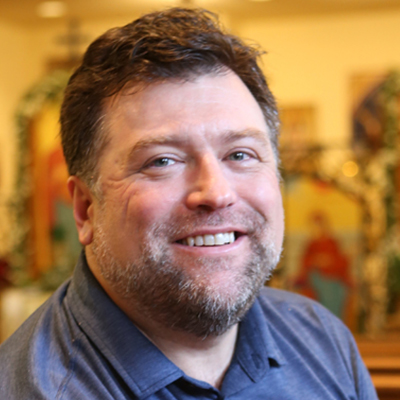Take me to “A Catholic’s Guide to Self-Help”
By Gerry Crete, Ph.D.
We’ve all heard a lot about meditation, and these days, it’s often associated with New Age or Eastern practices that faithful Catholics are rightly wary of. But what is Catholic meditation? How is it different from relaxation? From prayer? And can it be used appropriately to reduce anxiety?
Understand the Definitions
First, it’s important to understand the definitions of what we’re talking about. Meditation is essentially a method that helps individuals physically relax. We learn to breathe better and relax our muscles. Essentially, we are de-activating our sympathetic nervous system in order to exit from a fight or flight state.
Non-Christian Eastern forms of meditation such as yoga and transcendental meditation can provide relief at a basic human, physical level by calming the body. In general, most forms of Eastern meditation teach a person that, beyond the physical actions of calming the body, they will achieve a state of enlightenment by emptying the self of attachments.
Catholic forms of meditation are different from non-Christian meditation in the latter way. The key difference is that Catholic meditation should lead to knowing and experiencing God in a deeper and more personal way. Catholic meditation also calls us to concentrate our mind and heart on external revelation such as Scripture and the person of Jesus Christ, the Word Incarnate.
Learn from the Saints
In Catholic meditation, we are learning about something external. God is above the universe (transcendent) and present in the universe (immanent). God created the universe and all of us, and He relates to us in a personal way. We address God as “father” because He is relational and wants to connect with us as persons. As persons, we connect to God as three persons in the Holy Trinity.
In her masterpiece, The Interior Castle, St. Teresa of Avila teaches us that the soul in a state of grace can gain self-knowledge and explore the self at a deeper level. As a person meditates and progresses deep within the soul, he or she discovers Christ, the bridegroom. Catholic meditation in this context refers to a profound union with God.
In his masterpiece, The Spiritual Exercises, St. Ignatius of Loyola teaches us to apply all of our physical senses to an experience of God by meditating on the Scriptures. In this form of meditation, a person can picture oneself in a Gospel scene, for example the Last Supper, and engage the senses of smell, touch, taste, and sight as if one were present.
In both these examples, we don’t lose our personality and our uniqueness when we unite with God. Instead of being absorbed in an impersonal “ultimate reality” common in non-Christian meditations, our “person” is sanctified, glorified, and even divinified, according to the Greek Fathers. We are united with God through love, which can be defined as a continuous giving of self. The Trinity itself represents community, and the Trinity calls us into fellowship with Him. Catholic meditation has as its main objective entering into fellowship with the Holy Trinity.
Derive Human Benefits at the Same Time
When we participate in Catholic meditation, God allows us to experience natural, physical and human benefits as well. Meditation often reduces anxiety, which is the body’s natural response to a real or perceived threat. It can be used to help a person prepare for taking action or to self-soothe after an action. It can also be used to relax, calm, support, and ground people when their anxieties are irrational. Meditation and relaxation can lead to a decrease in blood pressure, respiration, heart rate, muscle tension, and obsessive thinking.
Real threats may include job loss, illness, and physical danger. All cause anxiety and rightly encourage us to some movement or change in behavior. In these times, we need to call on the Lord in prayer for courage and strength. Meditation can be used before or after an action in order to reconnect with God and His truth.
Perceived threats, on the other hand, usually take the form of worries. What if my presentation at work fails? What if my children do not keep the faith? What if I’m not careful, and I get a virus? These “what ifs” are not present realities but fears. Meditation here can be used to ground oneself in the truth of God’s love and presence.
Practice Catholic Meditation
Start practicing Catholic meditation by embracing the physical actions associated with any meditation exercise:
1) Sit in a comfortable position.
2) Take several deep breaths (abdominal/diaphragmatic) and gain awareness of your breathing.
3) Relax muscles (you may tense and relax your muscles starting from your feet and working upwards).
4) Focus on a single image, like visualizing a peaceful scene, or on a simple phrase, such as a Bible verse or the Jesus Prayer.
Couple that biblical or religious image or phrase with a thought that serves as a counterpoint to a negative belief, which can fuel anxiety. Here are a few suggestions:
I lost my job.
New mental response: This is a setback but I’m capable of finding a new option even if it takes time. It’s normal that I feel bad about this but my situation isn’t hopeless and I can rely on God, others and my own resources to get through it.
Meditation focus: He restores my soul. He leads me in right paths for his name’s sake (Psalm 23:3)
I’m in physical danger.
New mental response (after the danger): I’m safe now and I got through it.
Meditation focus: Imagine Jesus as the Good Shepherd protecting and guiding me. Option: Find an image of the Good Shepherd as a focus of your meditation.
What if my presentation at work fails?
New mental response: I’m a creative person and a hard worker. I did my best, and I can trust in God for the rest.
Meditation focus: Trust in the Lord with all your heart, and do not rely on your own insight. In all your ways acknowledge him, and he will make straight your paths (Proverbs 3:5-6)
What if my children do not keep the faith?
New mental response: I can do my best as a parent, and I have to trust God for the rest. I’m not perfect and I have made mistakes, but I can choose to love. Also, I have to receive love and take care of myself before I serve others.
Meditation focus: Imagine Jesus washing my feet and anointing me with oil.
What if I’m not careful and I get a virus?
New mental response: I can handle health challenges and know that God will be with me.
Meditation focus: Imagine walking side by side with Jesus or imagine Jesus embracing me. Repeat the words, “Jesus, I trust in you.”
In conclusion, we can meditate in the rich Catholic tradition of the saints while attending to the body, mind, and heart. We can focus our meditation on Christ and on the Holy Scriptures. We can incorporate healthy psychology that emphasizes truth over lies or “cognitive distortions.” We can know something is a false belief when it is inconsistent with the teachings of Jesus and His Church. Catholic meditation can help us move the truth from our intellect into our heart so that we don’t merely “know” that Christ loves us but we experience that love in a deeper way.
About Gerry Crete, Ph.D.
 Gerry Crete, Ph.D., is chief executive officer and co-founder of Souls and Hearts. He is a licensed marriage and family therapist and professional counselor in private practice. His practice, Transfiguration Counseling, is based in Atlanta, Georgia. In addition to marriage counseling, he specializes in the treatment of trauma and anxiety disorders. For more information about his private practice, please visit Transfiguration Counseling.
Gerry Crete, Ph.D., is chief executive officer and co-founder of Souls and Hearts. He is a licensed marriage and family therapist and professional counselor in private practice. His practice, Transfiguration Counseling, is based in Atlanta, Georgia. In addition to marriage counseling, he specializes in the treatment of trauma and anxiety disorders. For more information about his private practice, please visit Transfiguration Counseling.
